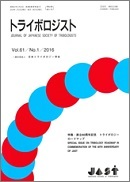61 巻, 9 号
特集・技術者のための倫理と知的財産
選択された号の論文の18件中1~18を表示しています
- |<
- <
- 1
- >
- >|
会告
-
2016 年61 巻9 号 p. K9
発行日: 2016/09/15
公開日: 2016/09/15
PDF形式でダウンロード (2512K)
目次
-
2016 年61 巻9 号 p. M9
発行日: 2016/09/15
公開日: 2016/09/15
PDF形式でダウンロード (596K)
連載・トライボロジーを語る
-
2016 年61 巻9 号 p. 557
発行日: 2016/09/15
公開日: 2016/09/15
PDF形式でダウンロード (534K)
記録
-
2016 年61 巻9 号 p. 558-561
発行日: 2016/09/15
公開日: 2016/09/15
PDF形式でダウンロード (1376K)
特集・技術者のための倫理と知的財産
-
2016 年61 巻9 号 p. 562
発行日: 2016/09/15
公開日: 2016/09/15
PDF形式でダウンロード (528K)
解説
-
2016 年61 巻9 号 p. 563-568
発行日: 2016/09/15
公開日: 2016/09/15
PDF形式でダウンロード (1129K) -
2016 年61 巻9 号 p. 569-574
発行日: 2016/09/15
公開日: 2016/09/15
PDF形式でダウンロード (964K) -
2016 年61 巻9 号 p. 575-581
発行日: 2016/09/15
公開日: 2016/09/15
PDF形式でダウンロード (786K) -
2016 年61 巻9 号 p. 582-586
発行日: 2016/09/15
公開日: 2016/09/15
PDF形式でダウンロード (841K) -
2016 年61 巻9 号 p. 587-592
発行日: 2016/09/15
公開日: 2016/09/15
PDF形式でダウンロード (1171K) -
2016 年61 巻9 号 p. 593-600
発行日: 2016/09/15
公開日: 2016/09/15
PDF形式でダウンロード (2505K) -
2016 年61 巻9 号 p. 601-606
発行日: 2016/09/15
公開日: 2016/09/15
PDF形式でダウンロード (1603K)
研究会報告
-
2016 年61 巻9 号 p. 607-614
発行日: 2016/09/15
公開日: 2016/09/15
PDF形式でダウンロード (1160K)
論文
-
2016 年61 巻9 号 p. 615-626
発行日: 2016/09/15
公開日: 2016/09/15
PDF形式でダウンロード (1957K) -
2016 年61 巻9 号 p. 627-635
発行日: 2016/09/15
公開日: 2016/09/15
PDF形式でダウンロード (1839K) -
2016 年61 巻9 号 p. 636-643
発行日: 2016/09/15
公開日: 2016/09/15
PDF形式でダウンロード (1314K)
会のページ
-
2016 年61 巻9 号 p. 644-649
発行日: 2016/09/15
公開日: 2016/09/15
PDF形式でダウンロード (1364K) -
2016 年61 巻9 号 p. 648
発行日: 2016/09/15
公開日: 2016/09/21
PDF形式でダウンロード (779K)
- |<
- <
- 1
- >
- >|
